|
Social
News 7/6
Japanese
Encephalitis threatening children’s lives
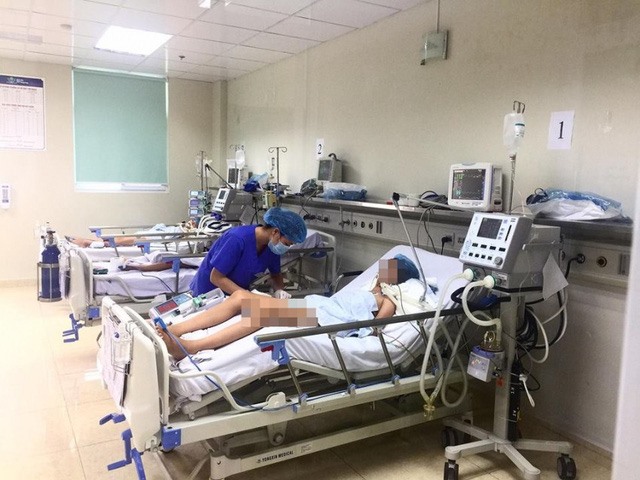
The thirteen-year-old
girl from Hải Dương Province was hospitalised after suffering from acute
fever and convulsions.—Photo dantri.com.vn
Thirty severe cases of Encephalitis—Meningitis are
being treated at the Department of Infectious Diseases of Việt Nam National
Children’s Hospital, reported Phụ Nữ Việt Nam (Việt Nam Women) newspaper.
Of all the cases, two children were diagnosed with the
deadly Japanese Encephalitis, a contagious disease carried by mosquitoes.
Both were not vaccinated properly, or possibly not at all.
Lê Quỳnh Tr., a thirteen-year-old from Hải Dương
Province was hospitalised after suffering from acute fever and convulsions.
The child was reported to be nauseous, unresponsive to antipyretics and
experiencing headaches. She then had doctors at a provincial hospital test
her condition, and perform a CSF (cerebrospinal fluid) puncture before
diagnosing her with the disease and moving her to the Việt Nam National
Children’s Hospital. Even while receiving respiratory help and being treated
with anti-edema drugs for ten days, the child’s condition remained unstable.
Another child suffering from Japanese Encephalitis,
Nguyễn Đức A, 15 months old, from Bắc Ninh Province, was luckier, acquiring a
stable state of health after just four days of similar treatment.
Japanese Encephalitis is a malicious disease with a
high risk of fatality (25—35 per cent), according to Đỗ Thiện Hải, vice
chairman of the Department of Infectious Diseases at the National Paediatrics
Hospital. He warned that the disease is difficult to diagnose in its early
stages since the symptoms resemble common infections, but after two or three
days discernible signs begin to emerge, such as sudden high fever, nausea,
dry vomit and dull reactions.
The disease spreads so quickly and severely that
children could experience tremors, fall into a coma, or even die after just a
day or two, Hải said. What’s more, complications that follow could impair
patients’ capabilities to communicate or work, he added.
The most efficient preventive step against Japanese
Encephalitis is through a proper vaccination process of three shots: the
first shot being given while the child is one year old, followed by the
second after a week or two, and the third a year later. Five to seven years
after that, the child will became vulnerable to the infection again, so the
process must be repeated until the child turns 15, Hải suggested.
The second best prevention is to ensure a clean
environment whereby parents frequently sanitise to prevent the growth of
harmful bacteria. Experts suggest sleeping with a mosquito net to refrain from
being bitten. When children are feverish or show signs of central nervous
system damage, they should be hospitalised promptly for timely diagnosis and
treatment.
Court reviews asset embezzlement case at PVP Land
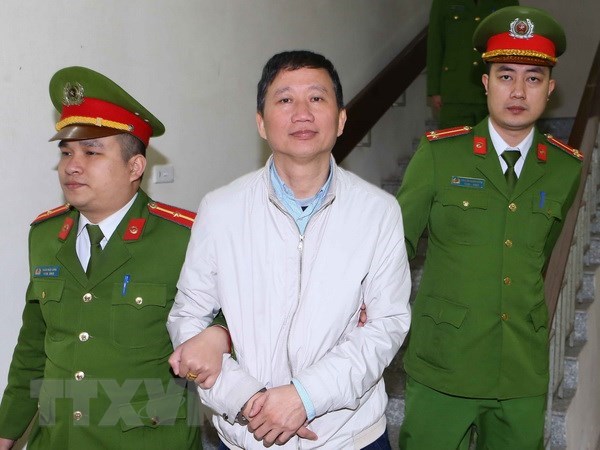
Trinh Xuan Thanh, former
Chairman of the Board of Directors of PetroVietnam Construction Corporation
(PVC), is led out of the court.
The High-Level People’s Court in Hanoi on June 5 opened
a trial to look into the appeals of the defendants in the asset embezzlement
case at PetroVietnam Power Land JSC (PVP Land).
The court is scheduled to last until June 7.
In February 2018, the Hanoi People’s Court sentenced Trinh Xuan Thanh, former Chairman of the Board of Directors of PetroVietnam Construction Corporation (PVC), to life imprisonment. Thanh’s accomplices, Dao Duy Phong, former Chairman of PVP Land’s Board of Directors, was given a jail sentence of 16 years. Dinh Manh Thang, former Chairman of the Board of Directors of Song Da Oil and Gas Investment and Commerce JSC, got nine years in prison. Le Hoa Binh, former Chairman of the Board of Directors of 1/5 Construction and Services JSC and Minh Ngan JSC, and Nguyen Thi Kim Thoa, former chief accountant of 1/5 Construction and Services JSC and Minh Ngan JSC were sentenced to eight-year and six-year imprisonments, respectively. Thai Kieu Huong, former Deputy General Director of Vietsan Investment JSC, and Huynh Nguyen Quoc Duy, a self-employed trader, each received a prison sentence of 10 years. All these defendants were charged with “asset embezzlement” in accordance with Article 278, Clause 4, Count a of the 1999 Penal Code (now is Article 353, Clause 4, Count a of the 2015 Penal Code), according to the court. Six out of the eight defendants lodged their appeals against the first-instance sentences. However, Thanh and Phong then withdrew their appeals. Meanwhile, Thang, Huong and Duy asked for a reduction of their jail terms. Thoa claimed she is innocent in the case. Phong’s wife, Nguyen Thuy Hoa, who was involved in the case as a person with related interests and obligations, also lodged an appeal requesting the return of 2 billion VND of the money that her family had paid to correct the consequences of the case as the cash is more than the requested amount. Between February and mid-April 2010, Thanh, as Chairman of the Board of Directors of PVC, along with Thang, Duy and Huong, with the support of Binh and Thoa instructed Dao Duy Phong and Nguyen Ngoc Sinh, representatives of PVC’s capital at PVP Land, and Dang Sy Hung, chief of PVP Land’s economic and planning division, to transfer 12.12 million shares of PVP Land at Trans-Pacific Services JSC – the parent company of Vietsan to Minh Ngan JSC with a price lower than the deposit price. They appropriated a differential sum of more than 87 billion VND (3.86 million USD). Of the money, Thanh arrogated 14 billion VND, while Thang pocketed 5 billion VND; Phong, 8 billion VND; and Sinh, 2 billion VND. The defendants received a total of 49 billion VND from the deal. According to the verdict of the first-instance trial, among the defendants, Thanh played the decisive role in the case, followed by Phong and Sinh.
Religious followers in Hanoi join hands to protect environment
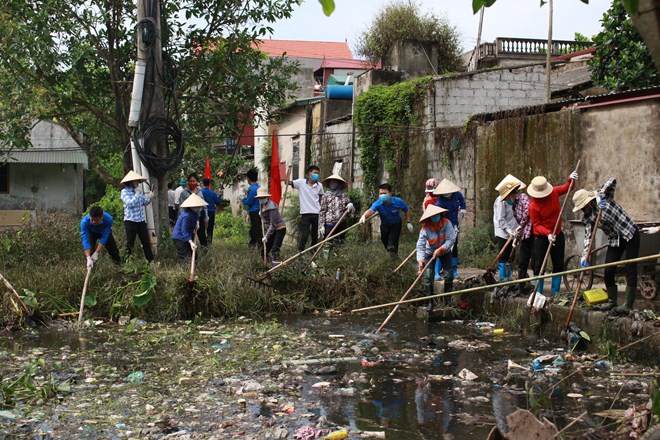
Residents in Tri Thuy
commune of Phu Xuyen district, Hanoi, clean a canal near Provincial Road 428
after an environmental protection campaign launched on June 5
Religious followers in Hanoi joined municipal
authorities in an environmental protection campaign launched at the church of
Hoang Nguyen Parish in Tri Thuy commune, Phu Xuyen district, on June 5.
The campaign was part of activities in response to the
World Environment Day (June 5) and the action month for the environment.
At the launching ceremony, President of the municipal Vietnam
Fatherland Front Committee Vu Hong Khanh said religious organisations have
done good work to protect the environment.
Efforts to protect the environment and respond to
climate change in the capital city have resulted in many positive outcomes
over the last couple of years, he noted, elaborating that the municipal
committee of the Vietnam Buddhist Sangha has combined environment-related
content with activities of Buddhist training schools.
The Caritas of the Archdiocese of Hanoi has organised
“Green Saturdays” to promote clean-up activities. The Hanoi Capital Oratory
of Caodaism has encouraged followers to practice food safety and use
vegetarian food. Meanwhile, dignitaries of the Bahá'í Faith called on its
followers to popularise environmental protection messages on the occasion of
the bicentenary of Bahá'u'lláh, the founder of the Bahá'í Faith, last year,
the official added.
He asked authorities, religious organisations and local
residents to continue working to protect the environment and respond to
climate change.
Priest Joseph Dao Ba Thuyet, head of the Caritas of Phu
Xuyen Deanery, described the campaign as a driving force for religious
followers to be more responsible in environmental protection. He also called
on all Catholics to act for a clean and beautiful world.
According to the municipal Department of Natural
Resources and Environment, activities have been taking place across the city
from May 15 to July 31 in response to the action month for the environment,
including promoting waste collection and treatment, stepping up examination
and settlement of projects with high pollution risks and enhancing
cooperation with foreign partners to ensure effective and sustainable use of
water resources.
Young ASEAN leaders contribute ideas to protect Mekong
Delta environment
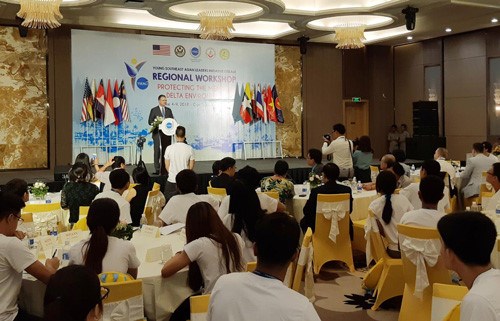
At the workshop (Source:
tapchicongsan.org.vn)
Some 120 young leaders from the Association of
Southeast Asian Nations (ASEAN) contributed their ideas to protecting the
environment in the Mekong Delta of Vietnam at a workshop which opened in Can
Tho city on June 5.
The event, which runs until June 9, was organised by
the US Mission to Vietnam and the Resource Centre for Community Development
from An Giang University.
Participants will study the consequences of changes in
the environment in the Mekong Delta such as landslides, salinisation, river
flooding, sea level rising, degradation of water resources and the effects of
building hydroelectric plants, which all impact on people’s lives and the
economic development of the region.
Through presentations, case studies, site visits and
interactive activities, participants will explore potential short and long
term solutions and strategies for addressing changes in the environment that
are causing serious consequences in Can Tho city and the Mekong Delta.
US Ambassador to Vietnam Daniel Kritenbrink said the US
government is investing for the sustainable future of countries in the Mekong
River basin.
Protecting the environment in the Mekong Delta not only
brings benefits for residents living along the Mekong River but also helps
promote development and security in Southeast Asia, he added.
The US will devise policies to support food and energy
resources in the Mekong Delta in the long run as well as programmes to
improve the management of water resources, reduce environmental pollution and
build clean energy solutions.
It will also carry out projects to help farmers develop
agriculture adapting to climate change, the diplomat said.
During their stay in the Mekong Delta, young Southeast
Asian leaders will make fact-finding tours to areas that bear the brunt of
climate change in An Giang, Can Tho and Bac Lieu.
The workshop is part of the Young Southeast Asian
Leadership Initiative (YSEALI) – a programme launched by the US government in
2013 to strengthen leadership development and networking in Southeast
Asia.
YSEALI seeks to build the leadership capabilities of
youths in the region, strengthen ties between the US and Southeast Asia and
nurture an ASEAN community.
Vietnam launches design for clean energy future
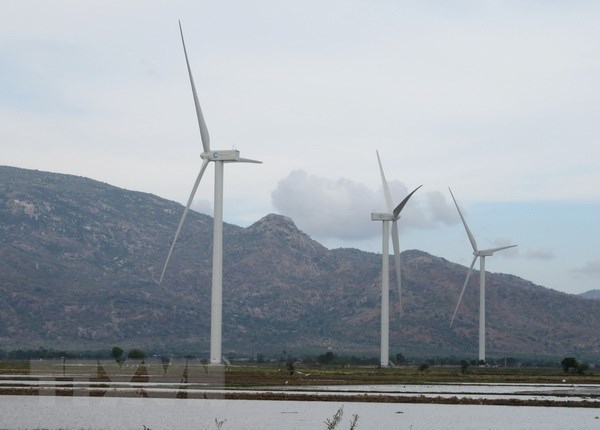
The Dam Nai wind power project
The design of a clean energy future in Vietnam was
announced at a conference held in Hanoi on June 5.
Nguy Thi Khanh, Executive Director of the Green Innovation and Development Centre (GreenID), said the design is the result of a GreenID study on development scenarios for electricity sources in Vietnam. With criteria focusing on health benefit, feasible cost, and national energy security, the research showed Vietnam might not need to build coal-fired thermal power plants but still archive energy security at affordable prices. Nghiem Vu Khai, Vice Chairman of the Vietnam Union of Science and Technology Associations (VUSTA), said green energy is a smart move for Vietnam in response to climate change, as the country hold potential in solar and wind power. Dao Trong Tu, deputy head of the Centre for Sustainable Development of Water Resources and Climate Change Adaptation, highlighted a number of benefits brought about by the design. According to him, the design will help ensure energy security in the country via reducing coal imports and avoid the construction of about 25 coal-fired thermal power plants by 2030, thus cutting the pressure of mobilising 60 billion USD for the building. As a result, the country will not have to burn approximately 70 million tonnes of coal per year, which also means Vietnam will save about 7 billion USD a year from cutting coal imports. The volume of CO2 emissions will drop by about 116 million tonnes annually, while the air and water will become less polluted. The design is estimated to help prevent 7,600 early deaths per year by 2030. Participants showed their approval of the design, stating that the study put forth a safe and suitable option in meeting Vietnam’s future demand for energy. The design presents a country adequate energy with the environment and human health protected, said Nguyen Trong An, Deputy Director of the Research and Training Centre for Community Development.
Border communes in Dak Nong connected to national grid
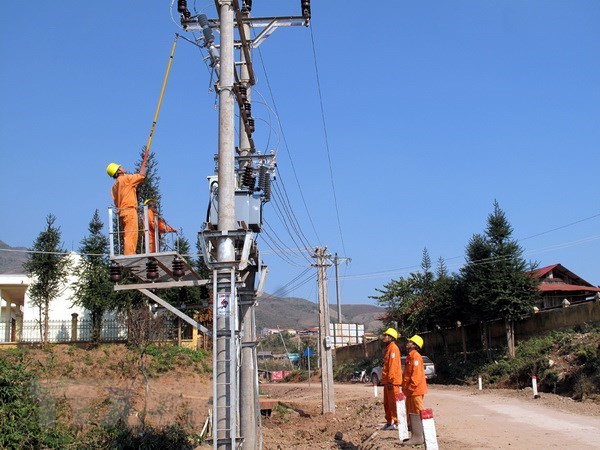
Almost 95 percent from Thuan Ha and Thuan Hanh border communes in Dak
Song district, the Central Highland province of Dak Nong, have accessed
electricity thanks to a local power project in 2014-2020 period
Almost 95 percent from Thuan Ha and Thuan Hanh border
communes in Dak Song district, the Central Highland province of Dak Nong,
have accessed electricity thanks to a local power project in 2014-2020
period.
Dak Song district has 21 hamlets to get benefits from
the project, prioritising the provision of electricity for 1,743 households
from 11 hamlets in Thuan Ha and Thuan Hanh communes.
In the first quarter of 2018, the Dak Nong Power
Company put into operation seven transformation stations with a capacity of
650kVA in Thuan Hanh commune.
The company also built a new transformation station
with a capacity of 100kVA along with a 1.6km medium-voltage power line and a
2.5km low-voltage power line for more 80 households.
Apart from upgrading the power network, the company has
also simplified procedures to supply electricity and promote the application
of information technology to improve customers caring services.
Director of the company Tran Van Thuan said the
implementation of power projects in border areas not only significantly
contributes to the local socio-economic development but also completing the
national target on rural electrification.
Dak Nong province shares over 120km borderline with
Cambodia.
As of 2017, 99.98 percent of communes nationwide and
98.83 percent of households accessed to electricity. One decade ago, the
rates were 97 percent and 93.4 percent, respectively.
Experts warn ASEAN countries against plastic waste
Southeast Asia is home to the world’s top marine
plastic polluters and environmental protection goals set by the governments
of regional countries are insufficient, warned experts on World Environment
Day (June 5).
Globally, some 8 million tonnes of plastic is dumped
into the oceans every year, threatening the marine life and entering the
human food chain, according to the United Nations Environment
Programme.
Five Asian countries, including China, Indonesia, the
Philippines, Vietnam and Thailand, account for up to 60 percent of the
plastic waste leaking into the oceans, according to a 2015 report by the
environmental campaigner Ocean Conservancy and the McKinsey Centre for
Business and Environment.
The five economies have "generated exploding
demand for consumer products", the report said, but lacked the waste
management infrastructure to cope with the surge in plastic garbage.
In Thailand, months after the military seized power in
a 2014 coup, the junta made waste management a priority and set goals for
2021.
They included cutting the use of plastic bags and
bottles in government agencies and businesses and plastic bans in tourist
destinations. A tax on plastic bags was also mentioned, along with a target
to recycle up to 60 percent of plastic by 2021.
Other governments have also set ambitious goals.
Indonesia, ranked second behind China in the 2015 study of mismanaged plastic
waste from communities living near coastal areas in 192 countries, has
pledged 1 billion USD a year to reduce marine plastic debris by 70 percent by
2025.
The Philippines has not imposed a nationwide ban on
plastic bags, but some local authorities regulate the use of the products.
Some shopping malls have also replaced plastic bags with paper ones and
encouraged reusable bags.
Malaysia is likely to introduce a nationwide ban on
plastic bags soon, said government officials.
Anchalee Pipattanawattanakul, an ocean campaigner with
Greenpeace in Southeast Asia, said the region needs a coordinated strategy on
plastic waste. She noted that ASEAN countries are aware of the issue, but
there is no action plan that will actually decrease the use of plastic.
Susan Ruffo, Ocean Conservancy's managing director for
international initiatives, stated that recognising the impact of plastic
waste is not just a government responsibility, as corporations, civil society
and citizens all have a part to play.
’Think Before You Share’ online safety campaign
launched in Việt Nam
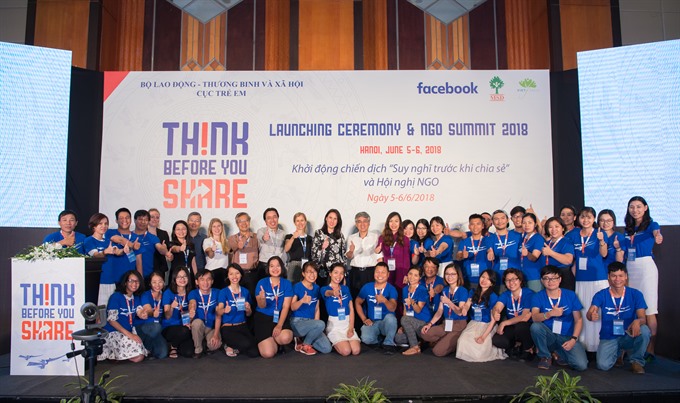
Facebook, in collaboration with the Management and Sustainable
Development Institute (MSD), officially launched “Think Before You Share,” an
online safety programme, in Việt Nam on June 5. — Photo MSD
Facebook, in collaboration with the Management and
Sustainable Development Institute (MSD), officially launched “Think Before
You Share,” an online safety programme, in Việt Nam on Tuesday.
MSD is a Vietnamese non-government organisation that
acts for the rights of marginalised groups, especially children and
youth.
Through a series of workshops, training sessions and
online resources, “Think Before You Share” will provide the youth with tools
and guidelines on sharing information safely and responsibly on social media.
“Keeping our community safe is core to everything we
do, and we want to help youth in Việt Nam make better decisions about what
they share online. With ‘Think Before You Share,’ Vietnamese youth will have
the tools they need to do just that. We are committed to working with local
partners to reach more youth across Việt Nam and build a positive online
community,” said Clair Deevy, director of Community Affairs, APAC at Facebook.
Executive Director of MSD, Nguyễn Phương Linh, said
that “The Think Before You Share” programme was an important part of her work
to support the online safety of young people and ensure they have the right
skills to contribute to creating positive online communities.
“The programme has been designed to help students analyse
content on social media and use their own critical thinking and empathy to
understand how it informs their opinion. We want to empower students as
digital citizens to use social media safely, smartly and create a positive
social media experience,” Linh added.
Facebook and MSD kick-started the campaign with a
two-day summit, which will be attended by more than 100 Vietnamese NGO
participants from 15 provinces and cities nationwide. The summit will provide
NGOs with tools and practical skills to enhance their efforts in building a
secure and useful network environment, create a positive online presence and
promote responsible digital citizenship. Through design thinking, critical
thinking and empathy, NGOs will create social campaigns that promote better
and safer online communities.
Besides workshops and training sessions, the initiative
will also make online resources and videos available, covering digital
literacy, online safety, critical thinking and empathy. As part of this
programme, these resources will continue to be shared by Facebook and its
partners in more than 100 schools across Việt Nam.
The programme, which will visit 15 cities and provinces
across Việt Nam, seeks to train approximately 30,000 youth aged between 13
and 18 years old, as well as 1,500 teachers, 100 NGOs, and more than 40 youth
trainers. In addition, the initiative aims to reach more than 250,000 youth
in Việt Nam online.
Prevent strokes since curing is difficult: doctors
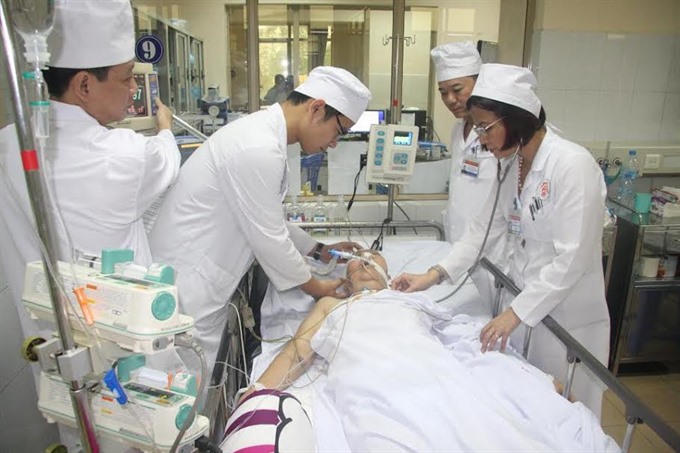
On a recent Saturday morning in the meeting room of Tâm
Đức Heart Hospital in District 7, HCM City, a seminar was held on “Atrial fibrillation
effective management: the role of new generation anticoagulants in preventing
stroke in atrial fibrillation patient”.
It was a unique event in the fact that all participants
were heart disease patients or people with an elevated risk of stroke.
The seminar disseminated useful information as doctors
discussed what causes atrial fibrillation (AF), how to control it and what
new generation anti-coagulants are available to treat atrial fibrillation.
The seminar has been a regular activity organised by
Tâm Đức Hospital in recent years for its stroke patients club.
Dr Tôn Thất Minh, the hospital’s director, said the
incidence of stroke is increasing globally and in Việt Nam due to modern
habits like smoking and eating fast food and work-related stress.
Yet people barely know about it, he said.
“They know a stroke is dangerous since it could cause
death. Many do not know how to protect themselves from the disease, how a
stroke will seriously affect their lives or what to do when a family member
suffers a stroke.”
A stroke will impact both the patient and their
families, he said.
It was for this reason that the hospital, with
sponsorship by Bayer Vietnam, set up the club for stroke patients to share
knowledge and experiences about the disease, how to prevent it and cure it,
how to take care of stroke patients, and how to use medicines correctly.
The club has achieved useful results.
Minh told Việt Nam News: “Patients’ knowledge has
significantly improved compared to two years ago. They know a lot about the
disease and some of them can talk about it like a doctor.”
Since in the case of stroke it is better to prevent
than cure, providing knowledge about it is critical, he said.
Trịnh Khắc Nhơn, 58, of District 3 told Việt Nam News
that two years after joining the stroke patients club in Tâm Đức Hosptial he
has acquired a lot of knowledge.
Before joining the club he would often seek information
on social networks or from people.
“There are many sources of news about medicines and
methods to treat heart diseases and stroke. But after joining the club I have
discovered all that information is not correct.”
He has been taught about new generation medicines and
how to use them.
He also said he has passed on to relatives and friends
the information he has acquired.
Nguyễn Thị Bích Hoa, 48, of District 1 is another
member of the Tâm Đức Heart Hospital’s stroke patients club. She regularly
goes to the club and, thanks to information acquired there, can take care not
only of herself but also her mother in the correct way.
Such a club has been set up not only at Tâm Đức
Hospital but also many other hospitals like Chợ Rẫy and Thủ Đức Hospital, and
they have become popular among patients and their families.
A stroke club is useful not just for patients and their
relatives since when someone gets a stroke, their whole family is impacted.
At a seminar Bayer organised in Singapore on stroke, a
stroke victim, Anthony Quek, surprised attendees by saying the lives of the
five other people in his family too had been affected after he had the
stroke.
He recalled the difficult early days, saying he
couldn’t walk or take a bath by himself, and needed his family’s support for
everything. Normal life had ceased to exist, and the five other members in
his family had to serve him.
Dr N Venketasubramanian Ramani of Raffles Hospital in
Singapore said: “A stroke occurs when the blood supply to any part of the
brain is blocked, which in turn cuts off the oxygen supply essential to the
functioning and survival of brain cells. If it is not treated early enough, a
stroke can damage the brain, which may leave it unable to function as it did
previously.”
A stroke is a medical emergency that can have serious
consequences for both patients and their families and friends, he warned.
At a seminar held to discuss stroke prevention for
non-valvular atrial fibrillation patients organised late last week by the
Vietnam Cardiology Association and sponsored by Bayer, Dr Nguyễn Lân Việt,
the president of the association said: “To achieve better stroke prevention,
especially in high-risk AF patients such as those who had a stroke, kidney
failure, etc, patients need to strictly adhere to the treatment regimen
regarding the use of anti-coagulants prescribed by doctors and informing
doctors in time about disease conditions.”
But while underlining the dangers of strokes, doctors
also assured that they are completely preventable.
“FAST” is an acronym that needs to be learnt by heart,
they said.
FAST refers to Face, Act, Speak and Time: When you
smile, is one side droopy? When you raise your arms, is one side weak? When
speaking simple sentences, do you slur or find you are unable to do it? The
doctors said anyone having any of these symptoms needs to be rushed to
hospital, the last important factor being “Time”.
Remember to take the patient to a hospital as soon as
possible since 60 minutes is considered the “golden hour” for treating a
stroke. Within 60 minutes is the best time for cells to recover, the doctors
said.
PM approves development plan for resettlement areas
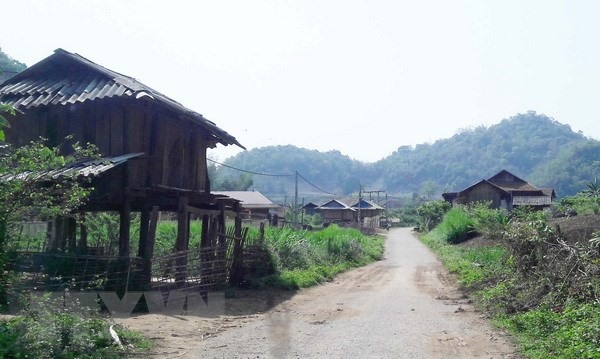
Part of a resettlement area in northern Sơn La province.
Prime Minister Nguyễn Xuân Phúc has approved a
socio-economic development plan for resettlement areas following the
construction of the Sơn La hydropower plant.
The plan will be implemented between 2018 and 2025 in
82 communes in Sơn La, Điện Biên and Lai Châu provinces.
Ahead of the plant’s construction, as many as 21,820
households, comprising 93,201 people, in these provinces were relocated.
The Sơn La hydropower plant is one of the key national
projects to supply electricity for socio-economic development,
industrialisation and modernisation. It will also play a significant role in
preventing floods during the rainy season and providing water in the dry
season to residents in the country’s north-west region.
The development plan aims to promote agricultural
production, increase the rate of trained rural workers and improve the
spiritual and material life of people after sustainable resettlement.
It targets to increase the per capita income of the
local people by two folds by 2020 from 2014 and reduce the rate of poor
households to below 10 per cent by 2020. The per capita income is expected to
increase by three folds by 2025 and the number of poor households by that
year is expected to reduce to zero, according to the plan.
The rate of households using safe water is expected to
increase to 90 per cent by 2020 and to 100 per cent by 2025.
The plan also aims to train and change the jobs of more
than 47,000 rural workers by 2020.
It will focus on upgrading and building infrastructure
in the resettled areas in Sơn La, Điện Biên and Lai Châu as well as stabilise
the living conditions and production of 500 households in Quỳnh Nhai and
Mường La districts in Sơn La province who were affected due to a shortage of
land or by landslides and flash floods.
The Sơn La hydropower plant, which became operational
in 2013, has six generators and a designed capacity of 2,400MW. It supplies
an average of 10.2 billion kWh per year to the national grid.
Thái Nguyên warns about rising streptococcus suis
infection cases
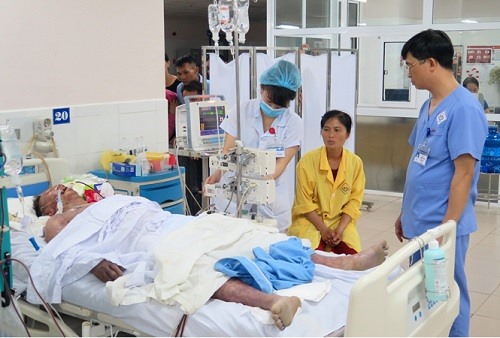
Thái Nguyên Central Hospital has raised a warning over rising
streptococcus suis infections, after two fatalities were reported within less
than a week of each other.– Photo baogiaothong.vn
Thái Nguyên Central Hospital has raised a warning over
rising streptococcus suis infections, after two fatalities were reported
within less than a week of each other.
Dr Lê Hùng Vương, head of the hospital’s Intensive Care
and Anti-poison Department said that at least two patients died of
streptococcus suis infection after eating unhygienic meat.
Ma Đình Du, 34, was hospitalised after cooking and
eating meat from a dead goat on May 27. He suffered from vomiting, severe
stomache ache and breathing difficulties. He died one day later.
La Văn Hào, 49, was in the same condition after being
hospitalised on May 31. The patient’s family said they had no idea what kind
of food he had eaten previously.
Hùng warned that streptococcus suis infection is on the
rise due to humid and hot weather. People should not eat raw meat, meat from
ill or dead animals and blood soup, to protect themselves from being
infected.
Đồng Nai to fund VNĐ10 billion to help fish farmers
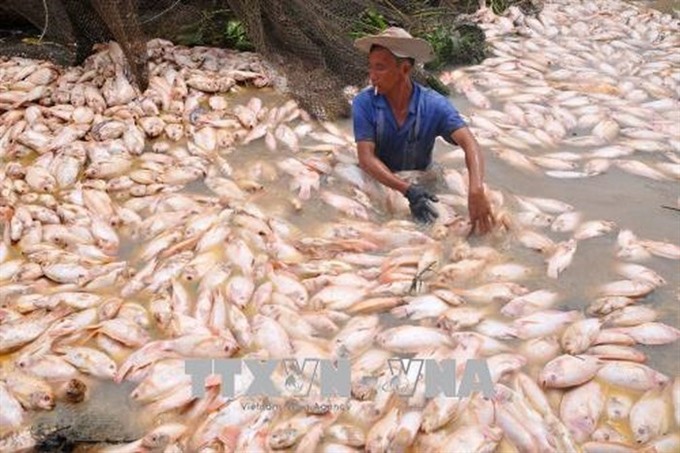
Local authorities said that a natural disaster caused the mass fish
deaths on the La Ngà River in Đồng Nai Province on May 20.
Đồng Nai Province plans to offer VNĐ10 billion
(US$438,115) to fish farmers affected by mass fish deaths on the La Ngà River
caused by a natural disaster two weeks ago.
The province’s People’s Committee said it was providing
assistance under a decree which calls for aid for farmers in case of losses
caused by natural disasters and epidemics.
More than 1,500 tonnes of dead fish were found on the
La Ngà River in the province’s Định Quán District on May 20. Many fish have
continued to die.
Most of the dead fish belonged to farmers in the
district’s La Ngà and Phú Ngọc communes. Most were lăng fish (hamibagrus),
diêu hồng fish (read tilapia) and chép fish (carp).
Huỳnh Thành Vinh, director of the province’s Department
of Agriculture and Rural Development, said an investigation was launched
immediately after the incident.
Samples of river water and dead fish were collected for
tests, while agencies inspected suspicious waste discharged from businesses
located upstream from where the deaths occurred.
Based on test results, scientists at the HCM City-based
Research Institute for Aquaculture No 2 and the Centre for Environmental
Monitoring and Analysis said the losses were caused by discharged waste water
from businesses.
Analysis showed that the decline of dissolved oxygen
content caused the fish to die.
The concentration of dissolved oxygen in the river
water was between 2.6 mg/l to 3.2 mg/l, but the required ratio was 4 mg/l.
The test also found an unusual level of NH4 (Ammonia),
5.6-11 times higher than normal, while NO2 (Nitrite) was 10-20 times higher
than the allowable levels for fish farming.
A heavy rainfall prior to the incident possibly carried
a large volume of water polluted with garbage and compounds from upstream. In
combination with NH4 and NO2, this also contributed to the fish
deaths.
In addition, the high density of fish and the narrow
distance between cages reduced the volume of oxygen in the living environment
of the fish, the local authorities said.
Emergency centre lacks infrastructure and personnel

Due to the lack of both infrastructure and personnel, Hà Nội’s
emergency centre is able to serve only seven out of every 100 calls.
Hà Nội’s 115 emergency department under the municipal
Department of Health currently has 21 ambulances which are able to serve only
seven out of every 100 calls, according to the centre.
The low response rate is blamed on lack of budget.
There are 22 ambulances but one has broke down waiting
to be scrapped, Nguyễn Thành, Hà Nội’s 115 centre’s director said.
Five medical emergency stations are placed citywide in
charge of saving people. One is the headquarter station at 11 Phan Chu Trinh
Street in the city centre. Four others are in the districts of Thanh Trì,
Long Biên and Hà Đông.
“According to World Health Organisation, there needs to
be 15 medical emergency teams to serve one million people. Hà Nội (with the
population of nearly 10 million) is in need of 150 taskforces,” Thành said.
“We have 14 emergency teams working every day and we
are unable to provide the service to outlying districts of expanded Hà Nội
area because they are too far away,” he added.
However, the problem causing the biggest headache
persists in personnel shortage.
Thành said since 2015, five doctors and ten nurses
asked to leave. Two doctors moved to other facilities.
The city now has 188 staff including 28 doctors, 25
nurse practitioners, 63 nurses, six pharmacists and 48 ambulance drivers.
“28 doctors is not enough. Literally 42 taskforces need
42 doctors,” he said.
Medical staff on the mission also have to suffer from
attacks from relatives of patients.
“Some encounter drug addicts. Right after seeing our
staff, they take out weapons. In some other cases, at the accident sites,
relatives of the victims told us ‘We don’t need you’,” Thành said.
He added that many doctors of the centre have not been
granted a work permit. The doctors are required to work at medical facilities
which have patient beds. But the 115 centre does not have beds so doctor who
even work here for ten years have not been certificated.
If ambulances come earlier and collaboration is better,
more people will be saved, Nguyễn Đình Hưng, director of Saint Paul general
hospital said, adding there should be more measures to support the centre in
the future.
Who will drive ambulances?
To save money, the centre did not ask to buy 150 new
vehicles with the budget forecasted to amount to hundreds of billions of đồng
but instead only replaced more than ten old ambulances, director Thành said.
But even when the ambulances are bought, who will drive
them, he asked, once again raising a headache question over personnel.
Hưng, director of general hospital of Saint Paul, said
that Hà Nội should follow emergency model of France where the centres are
managed by the hospital. This solution helps solve problems related to
infrastructure and personnel shortages. Following local authorities’ order,
the city will develop a network of emergency stations which connect with 115
centre and hospitals.
Then it is hoped a hospital specialising in emergencies
will be built. There needs to be four elements: a core hospital, a network of
ambulances, a training centre and a collaborating centre, he said.
Road at construction site facilitates illegal coal
mining
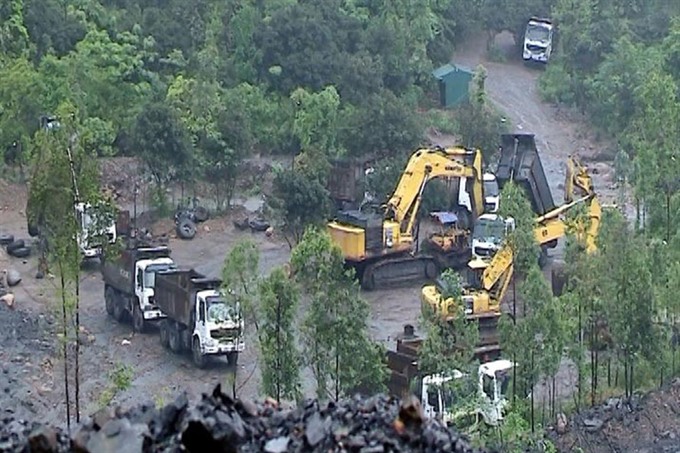
Equiment and vehicles are used for illegal coal mining at the road
leading to construction site of Hồ Thiên Pagoda. — Photo laodong.vn
The road which was opened to transport materials to the
construction site of Hồ Thiên Pagoda in Bình Khê Commune, Đông Triều Town, is
being used for illegal coal mining.
The town People’s Committee has asked the investor in
the road project to speed up the closure of the road and restore the
environment by the end of this month, Vietnam News Agency reported on
Tuesday.
The move followed a request by Secretary of the Quảng
Ninh Province’s Party Committee Nguyễn Văn Đọc late last month as the road
was not built according to the approved design. Moreover, it was reportedly
used by illegal coal miners.
The illegal coal mining left negative impacts on the
natural environment and destroyed the road from Ngọa Vân (Lying Clouds)
Temple to Yên Tử Mountain. The Hồ Thiên Pagoda is located on Phật Sơn
Mountain – a part of Yên Tử Range in Bình Khê Commune, Đông Triều Town.
The town People’s Committee sent a special group, led
by a vice chairman of the committee, to supervise the environmental
restoration, including the growing of trees there.
The local authority also carried out work to open a
road to transport materials to the pagoda construction site by following the
approved design strictly.
Yên Tử Mountain, located some 50km from Hạ Long City,
is surrounded with scenic landscape and ancient pagodas. This sacred mountain
is where King Trần Nhân Tông (1258-1308) abdicated his throne and founded
Trúc Lâm Zen. It is considered the capital of Vietnamese Buddhism.
VNN
|
Thứ Năm, 7 tháng 6, 2018
Đăng ký:
Đăng Nhận xét (Atom)
Không có nhận xét nào:
Đăng nhận xét